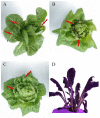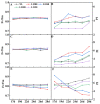Effects of Light Intensity on Growth and Quality of Lettuce and Spinach Cultivars in a Plant Factory
- PMID: 37765503
- PMCID: PMC10534974
- DOI: 10.3390/plants12183337
Effects of Light Intensity on Growth and Quality of Lettuce and Spinach Cultivars in a Plant Factory
Abstract
The decreased quality of leafy vegetables and tipburn caused by inappropriate light intensity are serious problems faced in plant factories, greatly reducing the economic benefits. The purpose of this study was to comprehensively understand the impact of light intensity on the growth and quality of different crops and to develop precise lighting schemes for specific cultivars. Two lettuce (Lactuca sativa L.) cultivars-Crunchy and Deangelia-and one spinach (Spinacia oleracea L.) cultivar-Shawen-were grown in a plant factory using a light-emitting diode (LED) under intensities of 300, 240, 180, and 120 μmol m-2 s-1, respectively. Cultivation in a solar greenhouse using only natural light (NL) served as the control. The plant height, number of leaves, and leaf width exhibited the highest values under a light intensity of 300 μmol m-2 s-1 for Crunchy. The plant width and leaf length of Deangelia exhibited the smallest values under a light intensity of 300 μmol m-2 s-1. The fresh weight of shoot and root, soluble sugar, soluble protein, and ascorbic acid contents in the three cultivars increased with the increasing light intensity. However, tipburn was observed in Crunchy under 300 μmol m-2 s-1 light intensity, and in Deangelia under both 300 and 240 μmol m-2 s-1 light intensities. Shawen spinach exhibited leaf curling under all four light intensities. The light intensities of 240 and 180 μmol m-2 s-1 were observed to be the most optimum for Crunchy and Deangelia (semi-heading lettuce variety), respectively, which would exhibit relative balance growth and morphogenesis. The lack of healthy leaves in Shawen spinach under all light intensities indicated the need to comprehensively optimize cultivation for Shawen in plant factories to achieve successful cultivation. The results indicated that light intensity is an important factor and should be optimized for specific crop species and cultivars to achieve healthy growth in plant factories.
Keywords: LED light intensity; indoor cultivation; nutrient content; photosynthesis; plant development; tipburn.
Conflict of interest statement
The authors declare no conflict of interest. The funders had no role in the design of the study; in the collection, analysis, or interpretation of data; in the writing of the manuscript; or in the decision to publish the results.
Figures












Similar articles
-
Optimal Light Intensity for Lettuce Growth, Quality, and Photosynthesis in Plant Factories.Plants (Basel). 2024 Sep 19;13(18):2616. doi: 10.3390/plants13182616. Plants (Basel). 2024. PMID: 39339590 Free PMC article.
-
Light/Dark Cycle Lighting Influences Growth and Energy Use Efficiency of Hydroponic Lettuces in an LED Plant Factory.Biology (Basel). 2025 May 20;14(5):571. doi: 10.3390/biology14050571. Biology (Basel). 2025. PMID: 40427761 Free PMC article.
-
Supplementary Far-Red Light for Photosynthetic Active Radiation Differentially Influences the Photochemical Efficiency and Biomass Accumulation in Greenhouse-Grown Lettuce.Plants (Basel). 2024 Aug 5;13(15):2169. doi: 10.3390/plants13152169. Plants (Basel). 2024. PMID: 39124286 Free PMC article.
-
Effects of different light intensities on lettuce growth, yield, and energy consumption optimization under uniform lighting conditions.PeerJ. 2025 Mar 31;13:e19229. doi: 10.7717/peerj.19229. eCollection 2025. PeerJ. 2025. PMID: 40183064 Free PMC article.
-
Towards a tailored indoor horticulture: a functional genomics guided phenotypic approach.Hortic Res. 2018 Nov 1;5:68. doi: 10.1038/s41438-018-0065-7. eCollection 2018. Hortic Res. 2018. PMID: 30393542 Free PMC article. Review.
Cited by
-
Side Lighting of Red, Blue and Green Spectral Combinations Altered the Growth, Yield and Quality of Lettuce (Lactuca sativa L. cv. "Yidali") in Plant Factory.Plants (Basel). 2023 Dec 13;12(24):4147. doi: 10.3390/plants12244147. Plants (Basel). 2023. PMID: 38140474 Free PMC article.
-
Extended photoperiod improves growth and nutritional quality of pak choi under constant daily light integral.Front Plant Sci. 2025 Aug 4;16:1621513. doi: 10.3389/fpls.2025.1621513. eCollection 2025. Front Plant Sci. 2025. PMID: 40831726 Free PMC article.
-
Wavelength and Light Intensity Affect Macro- and Micronutrient Uptake, Stomata Number, and Plant Morphology of Common Bean (Phaseolus vulgaris L.).Plants (Basel). 2024 Feb 2;13(3):441. doi: 10.3390/plants13030441. Plants (Basel). 2024. PMID: 38337974 Free PMC article.
-
Cross-species analysis of abiotic stress in hydroponic leafy crops reveals conserved regulatory networks and key divergences.Front Plant Sci. 2025 Jul 7;16:1613016. doi: 10.3389/fpls.2025.1613016. eCollection 2025. Front Plant Sci. 2025. PMID: 40692674 Free PMC article.
-
Optimal Light Intensity for Lettuce Growth, Quality, and Photosynthesis in Plant Factories.Plants (Basel). 2024 Sep 19;13(18):2616. doi: 10.3390/plants13182616. Plants (Basel). 2024. PMID: 39339590 Free PMC article.
References
-
- Tewolde F.T., Lu N., Shiina K., Maruo T., Takagaki M., Kozai T., Yamori W. Nighttime Supplemental LED Inter-Lighting Improves Growth and Yield of Single-Truss Tomatoes by Enhancing Photosynthesis in Both Winter and Summer. Front. Plant Sci. 2016;7:448. doi: 10.3389/fpls.2016.00448. - DOI - PMC - PubMed
-
- Kozai T. Sustainable Plant Factory: Closed Plant Production Systems with Artificial Light for High Resource Use Efficiencies and Quality Produce. Acta Hortic. 2013;2012:27–40. doi: 10.17660/ActaHortic.2013.1004.2. - DOI
-
- Yamori W., Zhang G. Feasibility Study of Rice Growth in Plant Factories. Rice Res. Open Access. 2014;2:1–6. doi: 10.4172/2375-4338.1000119. - DOI
-
- Shimizu H., Saito Y., Nakashima H., Miyasaka J., Ohdoi K. Light Environment Optimization for Lettuce Growth in Plant Factory. IFAC Proc. Vol. 2011;44:605–609. doi: 10.3182/20110828-6-IT-1002.02683. - DOI
Grants and funding
LinkOut - more resources
Full Text Sources

